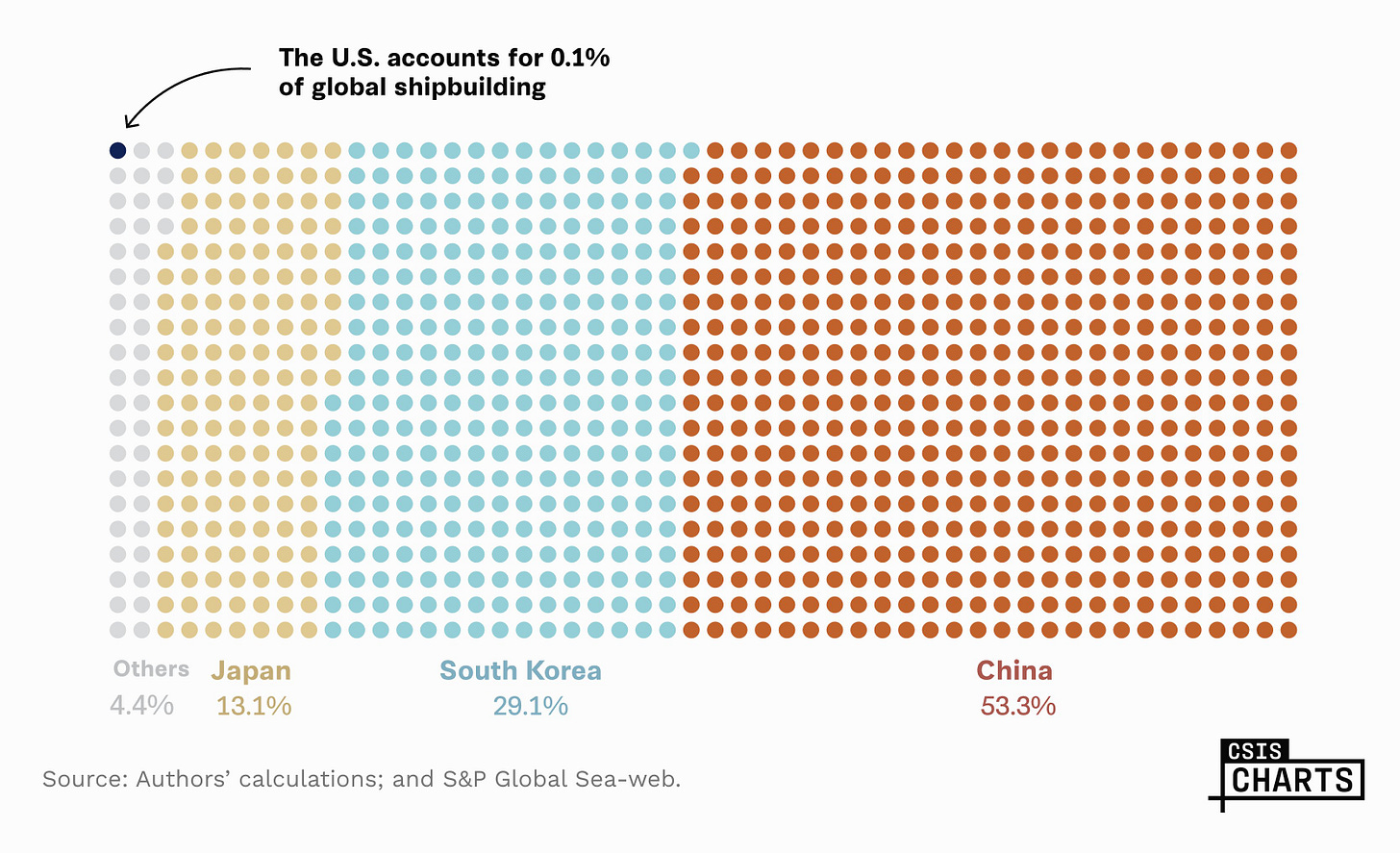Weekly Dose of Optimism #139
Dire Wolves, Base Power, ZBB Regulation, Zipline, Amca, Solano Shipyard
Hi friends 👋,
Happy Friday and welcome back to our 139th Weekly Dose of Optimism. Bit of a rollercoaster week, eh? Gotta keep things interesting, I guess? Well, behind all the ups and downs of the stock market and political jousting, it was a surprisingly jam-packed week on the good stuff front. We’re here to cover that stuff.
Let’s get to it.
Today’s Weekly Dose is brought to you by … HoneyBook
Running your own client-based business can be awesome. Your schedule. Your terms. No boss.
But it also means no support. You have to manage contracts, send invoices, collect payments, and schedule meetings all by yourself. That’s not what you’re best at, and not why you went independent. So for the past 12 years, HoneyBook has given independent entrepreneurs the tools they need to make all of the less fun parts easier.
Now, HoneyBook is starting to just handle all of that for you. By sprinkling AI onto a product that already understands your workflows, HoneyBook can automate more and more of the stuff that you don’t want to do so you can focus on the things that make you great.
This is literally the promise of AI. Freeing humans from drudgery to focus on creative pursuits.
Free yourself. Check out HoneyBook’s AI-powered platform today.
(1) The Return of the Dire Wolf
Jeffrey Kluger for Time
Relying on deft genetic engineering and ancient, preserved DNA, Colossal scientists deciphered the dire wolf genome, rewrote the genetic code of the common gray wolf to match it, and, using domestic dogs as surrogate mothers, brought Romulus, Remus, and their sister, 2-month-old Khaleesi, into the world during three separate births last fall and this winter—effectively for the first time de-extincting a line of beasts whose live gene pool long ago vanished.
You hear that howl? That’s the first time any human has heard that howl in 10,000 years. Dire wolves are BACK.
We’ve written a bunch about the company behind the Dire Wolves, Colossal Biosciences, the company with the mission of using genetic engineering to reverse extinction. First, it was about raising a boatload of money at a high valuation for seemingly far-flung science projects. Then it was about breeding woolly mice. And now, the company has straight-up de-extincted the dire wolf. There are literally dire wolves running around on some farm that, had Colossal never intervened, would never have ever existed in all future time.
Colossal sequenced the dire wolf genome from ancient DNA (there are plenty of dire wolf remains in North America) and identified 20 key genetic differences from modern gray wolves. They edited these genes in gray wolf cells, then cloned embryos using those edited cells. The embryos were implanted into large domestic dog surrogates, who gave birth to three healthy pups. These pups Romulus, Remus, and Khaleesi (great names) are now the first living dire wolves in over 10,000 years.
Now, do I think we need man more than three dire wolves roaming around? Personally, I’m good at three. Maybe there’s some case for using dire wolves for population control. But probably other ways to do that other than breeding packs of ancient wolves and releasing them into the wild. However, Colossal’s continued learnings and gene-editing innovations can be applied to other animals and maybe even one day be applied to preserve a certain very intelligent, thoughtful, and good-looking animal from going extinct in the first place. I’m look at you, pal!
(Packy note: There’s been some controversy over whether these are actual dire wolves. From Grok:
Colossal argues these pups represent a successful revival of the dire wolf, a species extinct for over 10,000 years, because they exhibit physical characteristics like larger skulls, white fur, and stronger jaws, which they associate with dire wolves.
Critics, however, argue these animals are not dire wolves but gray wolves with superficial modifications. Dire wolves (Aenocyon dirus) and gray wolves (Canis lupus) are distinct species, with some estimates suggesting they diverged evolutionarily 2.5 to 6 million years ago. Colossal’s process involved editing 20 sites across 14 genes in gray wolf cells, based on ancient dire wolf DNA from fossils, to mimic certain traits. Skeptics point out that this is far from reconstructing a full dire wolf genome, which would be nearly impossible due to the degraded state of ancient DNA. They argue the resulting pups are hybrids at best, with a genome still overwhelmingly gray wolf—sharing about 99.5% of their DNA with modern gray wolves.
You can watch Colossal’s Chief Science Officer, Dr. Beth Shapiro, address it here.
Not Boring take: if it howls like a dire wolf and bites like a dire wolf… it’s dire wolf enough for us.)
(2) Building America's Next-Generation Power Company
From Base
Today, we’re announcing our $200 million Series B funding round, led by Addition, a16z, Lightspeed, and Valor, with support from existing investors Thrive, Altimeter, Trust Ventures, and Terrain. Lee Fixel of Addition will join Antonio Gracias of Valor on our board. Our mission at Base is to fix the power grid and enable affordable & reliable electricity for all. To do that, we are building America’s Next-Generation Power Company; the first engineering-led, technology-focused, R&D-driven electricity company.
With the bases loaded, Base just hit a $200M grand slam Series B.
The company, which Packy Deep Dived here and plans to provide an update on next week, continues to violently execute against its mission of fixing the electric grid by building the Modern Power Company of the Electric Era. And now it has the capital and about as stacked of investor base as a 3 year old company could wish for to continue on with its mission.
Packy is going to go into much more depth early next week (be on the lookout), but I’ll try my best to summarize what Base does and why its important. The company manufactures, installs, and operates a distributed network of residential batteries, and taps its network to trade power and stabilize the grid. Batteries are super important; they transport electrons, which typically need to be use as produced, through time, and are necessary to balance the grid as we bring on more renewable energy and more electric products like cars, stoves, heat pumps, boats, and robots. Base currently operates in Texas, but the goal is to build America’s Next-Generation Power Company.
Short story: the more batteries Base installs, the faster and more effectively we can electrify America.
(3) ZERO-BASED REGULATORY BUDGETING TO UNLEASH AMERICAN ENERGY
From The White House
This regime of governance-by-regulator has imposed particularly severe costs on energy production, where innovation is critical. The net result is an energy landscape perpetually trapped in the 1970s. By rescinding outdated regulations that serve as a drag on progress, we can stimulate innovation and deliver prosperity to everyday Americans.
This order directs certain agencies to incorporate a sunset provision into their regulations governing energy production to the extent permitted by law, thus compelling those agencies to reexamine their regulations periodically to ensure that those rules serve the public good.
Speaking of American energy, the White House announced an executive order that essentially puts in place zero-based budgeting on federal energy regulation. The EO argues (and rightfully so) that excessive and outdated rules hurt innovation and productivity, especially in energy. To fix this, the EO forces agencies to add "sunset clauses" to their rules, which means the rules will expire unless they’re reviewed and re-approved.
We think this is a good thing. The EPA, DOE, FERC, and NRC are ripe for some zero-based budgeting. The “regulatory ratchet” has bogged these agencies, and the companies they regulate, down by decades of rules and regulations that together prevent the very outcomes they’re hoping to achieve. Let’s wipe the slate somewhat clean and build out a new rules framework that will both protect our environment and safety, while also allowing us to build and grow.
We don’t need to like everything Donald Trump does. The tariff rollouts were a disaster, and the negative impacts keep on coming even after the pause. If this were the Weekly Dose of Pessimism, the President would be the Star of the Week.
But this is actually an interesting and even … thoughtful? … application of his “burn-it-all-down” approach to policy making. A controlled burn. A healthy request to justify the rules that prevent us from building things. If we’re going to have to build everything in America, we need to at least make it possible to build.
(4) Zipline Drone Delivery Takes Flight in Texas With Walmart—For Free
Jack Daleo of Flying Magazine
The world's largest drone delivery provider announced Tuesday that residents located within 2 miles of a Walmart Supercenter in the suburb of Mesquite are eligible for delivery of more than 65,000 items in 30 minutes or less.
Speaking of cutting regulatory red tape in order to grow, if ANYONE gets in the way of these Zipline drones from delivering me my snacks we’re going to have a problem.
The drone logistics company announced a big step forward: it’s now providing its drone delivery services for Walmart customers in the Dallas, Texas area. Dallas is the company’s first major metro and will hopefully serve as a model for its delivery service rollout to other major metros in the U.S. To make this happen, Zipline is partnering with Walmart to provide 30 minute or less delivery of over 650,000 of the retailers items. About 80% of things sold in Walmart can be shipped via Zipline.
What Zipline is trying to pull off isn’t exactly new for them. They’ve done it before. The company has already executed millions of drone deliveries outside the U.S. in a number of West African countries and even Japan. The question is not whether drone delivery works, but whether drone delivery will work, economically, in the U.S. And this rollout into Dallas will go a long way in terms of answering that question.
We bet yes. Expect to see a lot of little guys zipping across the skies with your treats, necessities, and even medications in the years to come. Zip-a-dee-doo-dah.
For a little bonus Dose, check out Zipline co-founder Ryan Oksenhorn’s thread sharing the story of a Ghanaian girl bit by a snake and saved by Zipline here.
(5) Advanced Manufacturing Company of America
From Advanced Manufacturing Company of America
Today, we launched Amca with $76.5 million in funding and a vision to renew the spirit of the aerospace and defense industry’s golden age. Our launch funding was led by Caffeinated Capital with major participation from Founders Fund, Lux Capital, Andreessen Horowitz, and other world-class investors.
If your job at the new American sock factory or iPhone assembly plant doesn’t pan out, rest assured there’s an existing American manufacturing industry that could use an extra hand. I am talking about the aerospace and defense aerospace supplier industry. The supplier base is aging, underfunded, and increasingly overlooked, despite being absolutely essential to the performance of mission-critical systems. And just as these suppliers are becoming more and more essential, they’re faced with succession planning and technology gaps that make their future uncertain. This is the exact environment that attracted Not Boring portfolio company Hadrian to rethink and vertically integrate industry.
This week, another company entered the industry with similar ambitions to use capital, modern technology, agility in order to rethink the aerospace supplier industry. The Advanced Manufacturing Company of America (Amca) launched with news of raising $76.5M in initial capital and a strategy of combining a private equity roll-up strategy with a tech-forward operating model to revitalize the American aerospace supplier industry. They’re backed by some of the best in the biz and we’re rooting for them!
Bonus: California Forever is Bringing Shipbuilding Back to Solano County
Packy here. California Forever, which is building a new city in Solano County, California, announced plans this week to build the Solano Shipyard on some of the land that it’s acquired.
The need for American shipbuilding is urgent. As CF founder Jan Sramek highlighted in a thread, “Last year, one Chinese shipyard built more ships than every American shipyard – combined – since WW2.”
Understandably, then, the organization wrote in its blog post, “The Bi-Partisan SHIPS for America Act and the President’s formation of the White House Office of Shipbuilding have clearly made restoring America’s naval and commercial shipbuilding a national security imperative.”
I am a huge fan of the movement to build new cities. Build Esmerelda. Build Proto Town. Build NEOM. I’m also a proponent of building shipyards here, as any red-blooded Freedom’s Forge reader would be.
This one is particularly timely, though, because this week, I interviewed Conrad Bastable for Hyperlegible about his recent essay, Forsaking Industrialism. (Look out for that conversation this weekend.) He didn’t want to make prescriptions in the piece - the best industrial policy, he wrote, is to “Do all the things that matter and none of the things that don’t.” But I forced him to play President, and his answer looked something like what CF is proposing. To start, he proposed building regional industrial hubs with full industrial platforms — “Building the Solano Shipyard is a generational endeavor that would bring tens of thousands of jobs to not just the waterfront, but to co-located supply chain manufacturing facilities that would likely spring up across Solano’s cities and in the broader region,” CF writes — and putting a lot of new housing next to them.
After a long week and a half, we now know what reindustrialization shouldn’t look like. The Solano Shipyard is one version of what it should.
Have a great weekend y’all.
Thanks to HoneyBook for sponsoring. We’ll be back in your inbox next week.
Thanks for reading,
Packy + Dan







Weekly optimism hits different when it’s grounded in real products, not slogans. The fun part is tracking how consumer experiences evolve and which creators actually ship. For anyone curious how game design balances polish with payout psychology, see https://unionslots.co.uk/netent-slots/ for a clean breakdown of mechanics and themes. It’s a helpful lens on engagement loops before debating what “progress” even means. And yes, that perspective also explains why casino platforms keep winning user attention at the end of the day.
Thank you for a dose of optimism!